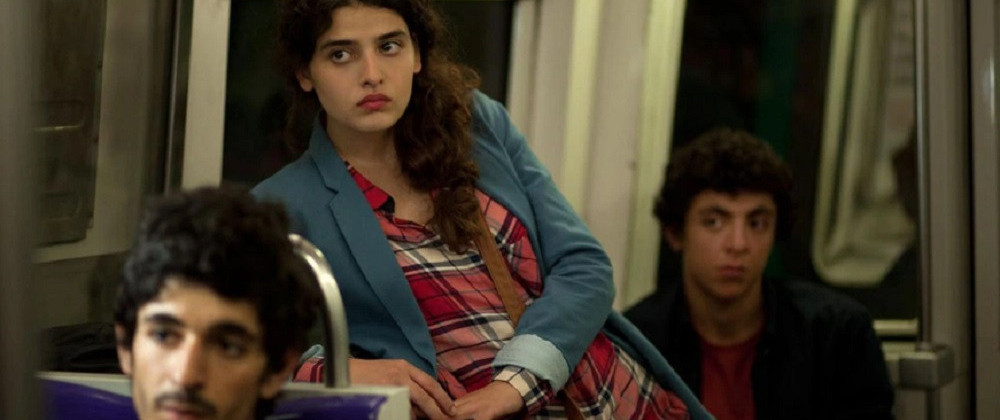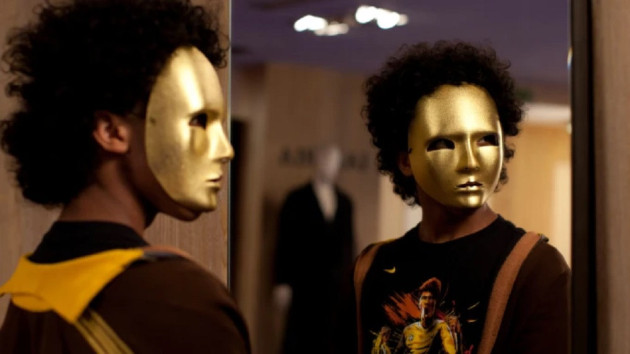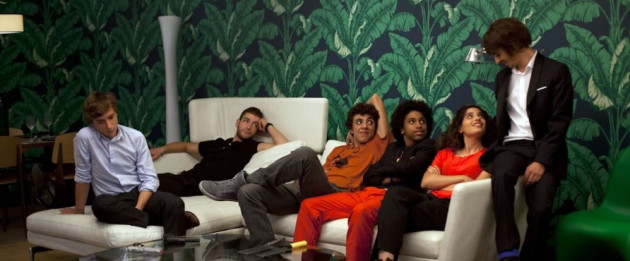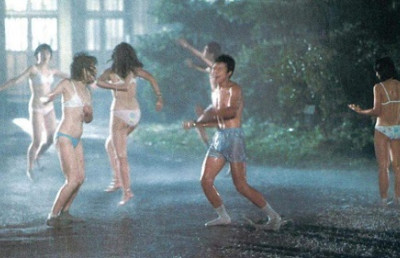Eerie Totality in Bertrand Bonello’s Nocturama

Nocturama, written, directed, co-produced and scored by French filmmaker Bertrand Bonello, arrived in 2016 amidst controversy for its portrayal of terrorism in Paris on the heels of the November 2015 Paris attacks. Its production began well before those violent incidents, however, and had already completed filming earlier in the year (Lucca 2017). The terrorism it depicts, while it shares certain characteristics as a coordinated attack with multiple targets, has little in common with that of the Islamist suicide bombers who stood outside the Stade de France in Saint-Denis and the gunmen who opened fire in the Bataclan theatre, among other locations, on November 13th, 2015. That didn’t stop the film from having a difficult landing in its native country. It was shunned from the Cannes Film Festival where otherwise it would have surely had its premiere, debuting instead at the Toronto International Film Festival, and its subject and themes became tangled with a reality distinct from the one it wished to confront. The terrorists of Nocturama do not appear to be linked by a clear ideology, ethnicity, class or religious background. They are a motley crew of young people, in their teens and early 20s, whose reasons for collaborating on a coordinated attack are ambiguous. We witness as they execute a carefully orchestrated series of bombings. Their targets include the Ministry of the Interior, the Stock Exchange, the Tour Total high-rise in the La Défense business district, and the golden statue of Joan of Arc near the Louvre. Afterwards, they hide out in a department store—played in exterior by the first arrondissement’s iconic La Samaritaine—after closing time, until they are found and killed by the state police. Less inspired by real world events of violence, Nocturama’s primary raison d’être revolves around its portrayal of contemporary French youth and a shared generational discontent. It is less about violence or terrorism than it is about the discontent behind that violence and what the meanings and effects of that violence may be and furthermore how such subversive actions fit into the larger contemporary moment and condition. This might seem odd when considering that film deliberately obscures their motivations and takes measures to reduce the narrative’s focus from a wider context to a minimalist, even abstract, tracking of actions and their consequences; or rather, a chain of cause and effect dislocated from any clear preceding causes and effects. However, Nocturama’s provocative withholding is strategic, by placing emphasis on what is there, Bonello expands the possibility of how we may consider what isn’t there.
The film is not a moral consideration of political violence. It does not support the actions of its characters nor does it go out of its way to condemn them. It removes that possibility by disallowing the spectator to fully know the motivations behind the actions. One cannot stand “with” the characters ideologically for we do not comprehend their ideology. Likewise, nor can the spectator stand “against” the characters on that basis, though we may find their actions abhorrent. We instead are invited to stand “alongside” the characters largely in a position of feeling rather than thinking. Bonello does not articulate the world outside and its machinations, but the spectator can be assumed to be familiar enough with them and accordingly can dream up a number of specific reasons as to why these young people chose to resist them. Or maybe they themselves don’t really know. The characters are implicitly positioned against an unarticulated totality of capital that markedly and paradoxically is felt through its absence and omnipresence as a non-subject. Nocturama is, in part, a zombie movie (without zombies). It is also a ghost movie (without ghosts) where totality exists in its spectral non-presence through manifestations of capital and consumerism which surround and enclose the characters. It is in this way that Nocturama approaches what Mark Fisher defines as, “the eerie”: “a particular kind of aesthetic experience,” in which “the sensation of the eerie clings to certain kinds of physical spaces…constituted by a failure of absence or by a failure of presence. The sensation of the eerie occurs either when there is something present where there should be nothing, or is there is nothing present when there should be something.” (2017, 61).
In sketching a vague angst with obscured political underpinnings, and the eventual ruthlessness with which that angst is itself resisted, Nocturama illustrates two sides of one coin of a “capitalist realist” present that underlines the notion that “it is easier to imagine the end of the world than to imagine the end of capitalism” (Fisher 2010, 2). Mark Fisher defines capitalist realism by “the widespread sense that not only is capitalism the only viable political and economic system, but also that it is now impossible even to imagine a coherent alternative to it” (2010, 2). In its refusal to allow any imagined alternative, the film may first appear to be a nihilistic or cynical exercise. While it certainly does not provide encouragement or hope of any kind, it provides a valuable and uncompromising look at disconcerting notions of a subject-less capitalist totality that swallows anything in its path while combatting spectator interpassivity. Nocturama is an example of “the eerie” in the form of a non-horror film that nevertheless peers into the horrors of capitalist totality as represented by a paradoxical presence-absence. In order to proceed, it is necessary to breakdown the film’s bifurcated structure and to engage with a textual analysis. As the essay continues, I will argue how Nocturama affirms and articulates insights and notions of Fisher’s capitalist realism while problematizing spectator interpassivity.

In the film’s first half, we are thrown, without explanation or exposition, into the carrying out of the bombings. We follow the characters as they simultaneously perform various tasks across Paris, moving the through the streets, riding the metro, and gaining access to spaces and monuments that they have targeted. Although we do not come to understand their guiding principles for the attacks, “the group’s targets all turn out to be sites or emblems of state and financial power” (Lim 2017). Their one human target is the Director General of HSBC. We can make a general assumption that whatever outrage is shared by the characters is vaguely directed towards the oppressive powers of capital. Nocturama meticulously tracks their movements and actions in accordance with a precise timeline denoted by intertitles. The clarity provided is only of the doing, the how but not the why. However, the film mysteriously and mischievously disrupts this strict temporality by freely moving between scenes from the day of the attacks and flashbacks that are contrastively not marked by any designation of time or any obvious linearity. The viewer is left to piece together what is past, what is present, and what may have taken place when, and furthermore what clues these scenes may give us to understanding the characters and how they came together. Some of the characters seem angry, some of them indifferent, some just cynical, and collectively perhaps even confused.
The flashbacks may represent other instances of characters coming together or getting to know each other but again it is not clear whether some have known each other for longer. Scenes ambiguously straddle the line between skeleton keys and red herrings. One such moment reveals an encounter between two friends, Yacine (Hamza Meziani) and Fred (Robin Goldbronn), and a stranger named Greg (Vincent Rottiers), by far the oldest and presumed eventual ringleader, in a waiting room before Fred and Greg each have a job interview for a company called ADS Surveillance (Fred’s later employment here plays a role in their plan). They connect briefly over their struggle to obtain employment. This may be the origin of this “terrorist” group, but we cannot be certain. From here it cuts to Greg at night in his apartment (the appearance of which suggests he is affluent), where he is on the internet reading an article about HSBC laying off nearly 50,000 workers. The film cuts to a scene where André, a university student, has trouble getting into an HSBC branch, when due to their security measures, he finds himself in a small entry room where he fails to provide adequate proof of his identification and gives up on depositing a cheque because of his claustrophobia in the tiny space. In the following scene, André is at a café with Sarah (Laure Valentinelli), advising her on the courses she’ll be taking at university. He describes an essay she’ll have to write in a history class. He previously chose the topic of “War and Totalitarianism since 1900” and explains how to structure the essay. Their dialogue toys with providing a window into their attitudes:
ANDRÉ: Always stick to the same plan. In part A, expose the problem and define it. In B, explain it. In part C, take it to its paroxysm to define the limits. And in D, suggest a solution. You can add a risky theory, too. Something politically incorrect, even unacceptable. Even if they don’t like it. They’ll want you to fuel the debate.
SARAH: What was your theory?
ANDRÉ: I ended saying the 20th century was proof that so-called democracy becomes its own enemy. It can only be judged by its enemies, not its results because the results brought us to the end of civilization.
SARAH: I don’t understand a word.
ANDRÉ: Going further, civilization is a condition for the downfall of civilization.
SARAH: I won’t take the exam.
ANDRÉ: Why not? It’s cool. (They’re interrupted by their server, who happens to be Yacine. He and André share an exchange and are clearly friends.)_
ANDRÉ: Historically, what comes after decadence?
SARAH: Rebirth?
ANDRÉ: And when rebirth is death, what happens? (Sarah’s boyfriend, David, enters, interrupting the conversation)
I would caution against over-scrutiny of any of these “clues” that Bonello gives us, at least in determining specifics, but I do think that they offer the viewer some possibilities. It is with those possibilities that the viewer must actively interact, not to simply construct narrative coherency, but to think along multiple strands of potential context around the film’s unfolding scenario. André’s glib, arrogant remarks suggests the flippant attitude of a rich kid trying to impress a young woman, and yet his provocations feel at once like clues into his (and the collective group’s) discontent. The unanswered question, about what happens when rebirth is death, however, feels like it belongs to the film itself. Other scenes show the whole group hanging out at Greg’s apartment and in a striking sequence, dancing together in the dark to electronic music, the camera weaving through their tentatively moving bodies as they slowly coalesce and huddle together. Is this the night before the attacks? This ritualistic moment feels like a collective last grasp at their youth before they knowingly give it away.
After they pull off the bombings, their after-hours access to the department store is made possible by Omar (Rabah Nait Oufella), a collaborator working as a security guard. Instructed to gag and tie up his fellow night shift surveillers, Omar inexplicably decides to kill them instead but hides this fact from the others in a tellingly discreet burst of pure violence that is but one suggestion of the distinct undercurrents of rage, frustration, and confusion harboured by the characters. The naive youth enter this bastion of consumerism with the belief they won’t be caught and that “nothing will ever be the same.” Exactly what changes they anticipate are never divulged. From the streets of Paris to the sleek, shiny interior of a multi-floored shopping centre, the characters spend their final hours surrounded by symbols of capital excess, and vapid mirror images of themselves via similarly adorned mannequins whose ominous presence is doubly effective as a reflection of the characters as well as a symbol of that which they oppose. Here then is the first hint that they may be their own unconscious targets.
There’s something of a Rivettian configuration to the film’s first half in its portrayal of a labyrinthine Paris and the tangled web of conspiracy it catches us in. In contrast to the playful mysteriousness of Out 1 (1971), Bonello’s game is purely one of nuts and bolts. In that sense, the films it more directly evokes are both Alan Clarke’s and Gus van Sant’s Elephant (1989 and 2003 respectively) for their matter-of-fact detailing of acts of violence abstracted from conventional narrative arcs. Violence is less of a subject in Nocturama though, and is more interested in setting up the context for exploring the consequential aftermath. It is here that the film moves from its terrorist thriller mode to one of eerie foreboding when our characters retreat to the department store to hide. Bonello’s clearest influences emerge, each from genre cinema: George A. Romero’s The Dawn of the Dead (1978) and John Carpenter’s Assault on Precinct 13 (1976). Nocturama borrows elements from each of these films while hollowing them out and removing their signature aspects: there are no actual zombies à la Dawn nor a drawn out standoff wherein our heroes bravely defend their fort as in Assault. Bonello works in the abstraction of these influences and synthesizes them into something purely and provocatively aesthetic. We, the viewers, are not afforded buffers of cinematic pleasure between us and the film’s harrowing content and yet we are knowingly “inside” cinema. There is something pointedly unsafe about the feeling of watching Nocturama. In one scene, Bonello recreates the famous Steadicam tracking shot from Stanley Kubrick’s The Shining (1980) wherein young Danny roams the halls in his tricycle, but here there are no ghosts waiting around the corner. The present is its own haunting. Why this mysterious homage other than to conjure the eeriness of its source? Speaking to postmodernism, Jameson argued, “all that is left is to imitate dead styles, to speak through the masks and with the voices of the styles in the imaginary museum” (1985, 115), but Bonello seems to be up to something more sly and self-aware. If anyone is guilty of empty pastiche, it is the young characters themselves in their imitations of terrorism. Their violence is bound to consumption. They can mimic destruction but not imagine creation. With demonstrably different ethnic and class backgrounds, the characters perhaps instead share a common affective response to contemporary capitalist precarity—but this affect flattens all else and emerges, or expresses itself, as something vague, and ultimately benign.

There’s a sickening irony in how the first half of the film finds the characters attacking old symbols of capital and civilization and the second half finds them take comfort and refuge in one of its most blatant contemporary manifestations, nestling in the belly of the beast, trapped by the literal structure of what they oppose. The characters do not represent an alternative so much as a further symptom, their seemingly subversive gestures are in fact just the anxious twitch of begrudgingly grinding cogs in a solely capitalist landscape, their generation robbed of a “thinkable horizon” outside capital (Fisher 2010, 8) that they can only flounder within it, symbolically buried in the tomb of a postmodernist mecca but not before admiring and playing with the material possessions that surround them, from big screen TVs, to state-of-the-art sound systems, to designer clothes. The characters are their own zombie antagonists.
Nocturama introduces us to the angular interiors of the department store with slick, gliding tracking shots, revealing its geography to us before the characters seize the space and peruse its glistening, ornate displays of fashion, home theatre appliances, and housewares. Bonello’s own synth-driven Carpenter-esque musical score kicks in as the characters spread out and get their lay of the land. The youngest of the cohort, Mika (Jamil McCraven), immediately finds himself lost and trapped in a stairwell, struggling to find his way back to the group. The slowly creeping camera creates an ominous tone that ensures certain doom and also seems to promise something distinctly horrifying. The reality of their actions appear to set in at different paces for each character, and they avoid talking about it head-on, choosing instead to wander the floors, “borrow” items of clothing, and test out equipment. Omar fires up some pop music and turns on the display TVs. A report on their attacks plays on the evening news. Several of them gaze with inscrutable stares before David (Finnegan Oldfield) asks Omar what song is playing. It’s “Whip My Hair” by Willow Smith. “It’s totally sick,” remarks David, as a montage of the fiery images of their violence plays against the beat and becomes a music video. The characters spend most of their time apart. Some play with toys, others with weapons. Some seem calm, some seem visibly shook. The night becomes something of a masquerade, as they don their new outfits and playfully slip into disguises. Their identities are not only unclear to us but also unfixed, characterized by the malleability of their youth. Mika wanders around in the department store in a gold mask he finds which reduces him to a zombie-like mannequin himself. He seems full of despair. Is that despair from his conscience, having participated in an act of violence? Or is it the very despair of existing in the world which made him want to burn it down to begin with? Yacine, in drag, delivers a lip-synching rendition of Shirley Bassey’s “My Way” for his comrades. This exuberant performance is briefly interrupted with a hard cut to the exterior of the store as sirens take over the soundtrack. The camera zooms in on the building. They are trapped, and not simply just within the building but within a looming totality that surrounds them inside and outside their hideout. Their fate is closing in on them. The scene cuts back to Yacine as he finishes the song, his mouth agape in mimicry of delivering its last note but he looks as if he could be screaming.
The film’s second half is not entirely confined to the inside of the department store as, unbeknownst to the others, David slips outside on a couple of occasions for a cigarette. During his first smoke break, he encounters a homeless man named Jean-Claude (Luis Rego), whom he invites to come inside along with his wife. This gesture seems generous but in fact it will lead to their death. Later, the execution of this poor couple underlines the inhumanity of the state police force’s violence. They make no effort to distinguish between the guilty and the innocent, and shoot down even those who surrender without the slightest hesitation. Regardless of the viewer’s feelings toward the terrorists, it is impossible not to be unsettled by this unwavering, indiscriminate demonstration of authority and punishment. Fisher argues that one way to work against capitalist realism may be to invoke “the Real(s) underlying the reality that capitalism presents to us” (2010, 18). Bonello’s depiction of the tactical, uncompromising slaughter of these young criminals is a potential uncovering of one such Real. During another one of David’s smoking breaks, he ventures further away and encounters a young woman (Adèle Haenel). He asks her if she knows what is going on with the bombings. “They say it’s war,” she explains before offering her opinion that “it was bound to happen”. Whether her statement expresses a solidarity with David’s cause is not clear but what is significant about this remark is it suggests destruction is inevitable, that there’s an understanding that such actions are a logical consequence of some kind.
After seeing on the news that their hideout has been located by the police, David peaks outside to try and spot a sign of them, and sees no such imminent threat. Soon though the police infiltrate the building and take care of business in short order. Even then, the totality remains outside and invisible, hidden in the otherwise quiet night. The police are merely tools performing their designated function on behalf of an entity that governs them and their victims alike. Nocturama creates the feeling we are watching a horror film, as well as a conspiracy film featuring the conspirators, in which we feel like we are tangled up in something beyond our understanding. In reality, it couldn’t be simpler: a group of kids blow stuff up out of frustration and are killed for it. However, Bonello imbues the film with the tonality of a film with something to reveal or be revealed that never will and perhaps cannot be defined whatsoever, giving us the inkling that we are witnessing something wrong unfolding distinct from the literal wrongs that the film depicts.
The looming totality that dwarfs all casts a shadow over the entire film. In Capitalist Realism (2010), Fisher refers to the “corporate affective tonality” (68) of Alan Pakula’s The Parallax View (1974) in reference to qualities of the film observed by Frederic Jameson in The Geopolitical Aesthetic: Cinema and Space in the World System (1992). In detailing The Parallax View’s mapping of a connective tissue of a corporatized totality and an according affect, Jameson makes reference to that film’s “nagging stylistic peculiarity” and something about it that is “imperceptibly unnerving.” (64). Perhaps we can liken such qualities to the “eeriness” of Nocturama, which could be described as a “capitalist realist affective tonality”. The film creates the sense of an all-encompassing, inescapable black hole. Concrete reality—the explosive violence on monuments in the first half and the immaculate marble, plastic and metal sheen of the second half—is de-stabilized by a pervasive sense of that which is intangible yet imbues everything. The department store is one of Fisher’s eerie “landscapes partially emptied of the human” and a perfect space wherein to evoke the “immaterial and the inanimate” (2017, 11). The material surfaces and objects in Nocturama feel as though they exist less than the unseen, a seductive mirage. Fisher describes the intrinsically eerie nature of capital as, “an eerie entity: conjured out of nothing, capital nevertheless exerts more influence than any allegedly substantial entity.” (2017, 11). Later, in the chapter “Approaching the Eerie”, he elaborates:
Since the eerie turns crucially on the problem of agency, it is about the forces that govern our lives and the world. It should be especially clear to those of us in a globally tele-connected capitalist world that those forces are not fully available to our sensory apprehension. A force like capital does not exist in any substantial sense, yet it is capable of producing practically any kind of effect. (61).
The influence of capital exerts itself not just in relation to the motivations of the characters and the targets of their attacks in Nocturama, but on their behaviour, their surroundings, their interactions, the dynamics between themselves, media, and media products. It’s everywhere. Furthermore, Fisher links the eerie to questions of agency and the notion of the unknown. The ambiguity of what agent is acting, or whether an agent is acting whatsoever, helps create and sustain “the eerie”. There is very little antagonism to be found within the characters aside from the psychological suggestiveness of some of their destructive gestures and the antagonistic force of the state only makes itself known at the end through the efficient violence of the police force who slay the characters, but these officers are merely an anonymous manifestation, not unlike the mannequins, who are instructed to kill on behalf of something that remains invisible, nowhere and everywhere at the same time. These climactic killings do ensure, however, that nothing will be illuminated, either for the characters or for the viewer, and certainly not for the world outside. “The eerie concerns the unknown; when knowledge is achieved, the eerie disappears,” argues Fisher (59). Suffice to say, the eerie never disappears in Nocturama, even after the movie is over.
It is in part this conjuring of the eerie that helps obstruct interpassivity on the part of the viewer. In Capitalist Realism, Fisher applies Robert Pfaller’s concept of “interpassivity” to how cultural objects like movies can perform “our anti-capitalism for us” by explicitly criticizing capitalism within the safe confines of an entertainment product (he specifically cites Disney/Pixar’s Wall-E from 2008) that manages to reassert capital’s domination of our consciousness. If we can “combat” capital passively via spectatorship, we can more easily accept its total presence in our lives (12). In the lack of specificity of Nocturama’s portrayal of capital, and in the total lack of clarity of one single antagonistic entity, there is no defined subject to resist. We cannot fully side with the young characters for aforementioned reasons, but we likewise cannot side with the forces of capital that antagonize their and our lives. We recoil in horror at the sight of the police brutally executing them. In fact, I would argue that it is easier for the viewer to quickly leap to identifying the actions of the state apparatus as wrong than that of the characters once we witness the climactic executions. But the police are not the subject or object of capitalist antagonism or totality either. We are refused any explanation, logic, or resolution in any sense. The film simply ends once the characters are dead. Nothing aside from their lives has concluded. The viewer is unable to locate avatars of identification, a failed righteous cause to lament, nor any kind of justice to celebrate. There remains that which was there from the beginning, the eerie capitalist realist tonality and the totality that is evoked but not grasped. There is no way to emerge from Nocturama with satisfaction or a definitive viewpoint with which to align. Bonello only gives the viewer something to reject. The viewer is left dissatisfied with the characters actions as well as the dystopian present. It beckons for the very imagination it itself knowingly lacks, not just its characters but its creator. It is a cry for help. Where many films would double-down on their anti-capitalist gestures only to create interpassivity, Bonello presents us with lack, insufficiency. If it does not contribute to the anti-capitalist imagination, it does so from a point of view on the oppositive of the naivete of its characters, one that squarely depicts the opposite of anti-capital imagination: “here is capital imagination, look at it, it is real, it is all around us, it is all I see.” How can these characters resist capitalism when capitalism is all they know?
The processing of their violent actions and its associated guilt or even trauma is internalized and unarticulated and therefore becomes indivisible from whatever grievances they have and share regarding the very circumstances they at first sought to rebel. The unknowability of the characters’ inner worlds as they undoubtably contemplate—but pointedly elude—confronting their actions while possibly also dreaming of the world they would prefer to live in, in effect, creates a collapse. In place of any psychology, Nocturama gives us anguish without definition. In so doing, this palpable malaise becomes attached not to ideology, not to political aim, not to guilty consciences, but to all and none of these things. Thus, the violent actions of the young terrorists, the violent actions of the state, and the violence of the world at large collapse into one tragic object produced by late capitalist society.
André, who boasted to Sarah of his proficiency in navigating university exams not upon concrete knowledge but the ability to perform knowledge for the system, has the same features of capital itself, to interpassively adopt rhetoric in order to carry on accordingly. There is no sense of him meaning what he says, writes, nor claims. Language and knowledge are images or simulacrum and even this subversive agent is a programmed individual. We can presume that his act against the system is meaningful and sincere, or we can perhaps speculate that it is his understanding of the fraudulence of it all that leads to his destructive impulse. He knows it is not real but he is it. My argument here is that Nocturama is the depiction of an unconscious mass suicide by a group of young people who grasp but do not understand that they are inherently that which they wish to exterminate from society. Plagued by the very knowledge that “something is missing” (Fisher 2010, 22), they creep over invisible cracks and fissures and are part and parcel of capital, knowing in their heart it is bad but yet all they know, even after taking action, is to indulge in its comforts, and its hyper-mediated consumer culture. It’s a short-circuit, the story of the robot who comes to know itself but cannot change itself, or quasi-self-aware zombies in denial, who are so oppressed by the culture that bore them that they cannot imagine its alternative. In spite of their claims that “nothing will be the same”, what they really mean is they are that nothing and the only option is through the exit door. The state will happily comply with their wish. It plays out almost like a transaction.
The biggest tragedy in Nocturama is the utmost certainty that no one will look to the real causes of their violence, that there will be no reflection, no communication, no discourse other than that which serves the reinforcement of the status quo itself. There is no dialogue between the characters and the state, no dialogue between media and citizens, and no dialogue between the police and their employers. It will all blur into the vague cause and effect of the everyday as if it were as normal as withdrawing cash from the ATM. An invisible entity that is not seen but felt in its totality, capital is depicted in Nocturama as a “cause-that-is-not-a-subject” (2010, 70), and here it wills living subjects out of existence, by the hands of the state, with whom they are collaborators.
Works Cited
Bonello, Bertrand. Nocturama. Wild Bunch, 2017.
Lucca, Violet. “Directions: Bertrand Bonello.” Film Comment, Jan. 2017.
Fisher, Mark. The Weird and the Eerie. Random House Inc, 2017.
Fisher, Mark. Capitalist Realism: Is There No Alternative? Zero Books, 2010.
Lim, Dennis. “Essays: Dennis Lim on ‘Nocturama.’” Grasshopper Film 2017.
Rivette, Jacques. Out 1. Les Films Du Losange, 1971.
Clarke, Alan. Elephant. BBC Northern Ireland, 1989.
Van Sant, Gus. Elephant. HBO Films, 2003.
A. Romero, George. Dawn of the Dead. Laurel Group, 1978.
Carpenter, John. Assault on Precinct 13. CKK, 1976.
Kubrick, Stanley. The Shining. Warner Bros., 1980.
Jameson, Fredric. Postmodernism and Consumer Society. Hal Foster (ed.), London, Pluto. Pub., 1985.
Jameson, Fredric. The Geopolitical Aesthetic: Cinema and Space in the World System. Bloomington : London: Indiana University Press ; BFI Pub, 1992.














